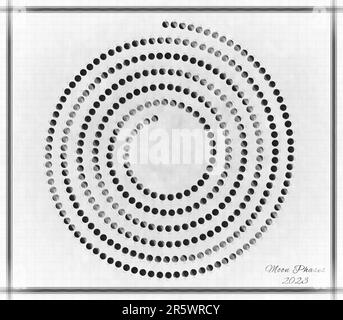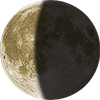

MOOM PHASE LAST NIGHT FULL
When the moon is in its full phase, it is passing behind the Earth with respect the sun and can pass through Earth's shadow, creating a lunar eclipse. Lunar eclipses are inextricably tied to the full moon. To find out where and when you can see the next lunar eclipse check out our lunar eclipse guide. In fact, the moon will often look roughly the same on two consecutive nights surrounding the full moon. So when a full moon rises, it’s typically doing so some hours before or after the actual time when it’s technically full, but a casual skywatcher won’t notice the difference. Usually the moon passes above or below the sun from our vantage point, but occasionally it passes right in front of the sun, and we get an eclipse of the sun.Įach full moon is calculated to occur at an exact moment, which may or may not be near the time the moon rises where you are. Because the moon’s orbit is not exactly in the same plane as Earth’s orbit around the sun, they rarely are perfectly aligned. Next, the moon moves into the waning crescent phase as less than half of its face appears to be getting sunlight, and the amount is decreasing.įinally, the moon moves back to its new moon starting position. The sun's light is now shining on the other half of the visible face of the moon. This is the waning gibbous phase.ĭays later, the moon has moved another quarter of the way around Earth, to the third quarter position. Next, the moon moves until more than half of its face appears to be getting sunlight, but the amount is decreasing. The moon’s disk is as close as it can be to being fully illuminated by the sun, so this is called full moon.

When the moon has moved 180 degrees from its new moon position, the sun, Earth and the moon form a line. This phase is called a waxing gibbous moon. More than half of the moon's face appears to be getting sunlight. This thin sliver is called the waxing crescent.Ī week after the new moon, the moon is 90 degrees away from the sun in the sky and is half-illuminated from our point of view - what we call first quarter because it is about a quarter of the way around Earth.Ī few days later, the area of illumination continues to increase. There are four phases of the moon, new moon, first quarter moon, full moon and third quarter moon.Īt new moon, the moon is between Earth and the sun, so that the side of the moon facing toward us receives no direct sunlight, and is lit only by dim sunlight reflected from Earth.Ī few days later, as the moon moves around Earth, the side we can see gradually becomes more illuminated by direct sunlight. On average, the moon rises about 50 minutes later each day, which means sometimes it rises during daylight and other times at night. As the moon revolves around Earth, it is illuminated from varying angles by the sun - what we see when we look at the moon is reflected sunlight. So, the moon always shows us the same face there is no single "dark side" of the moon. It also takes about 27 days for the moon to rotate on its axis. The moon is a sphere that travels once around Earth every 27.3 days. The moon phases of June 2023 and their dates. November: Corn Moon, Milk Moon, Flower Moon, Hare Moonĭecember: Strawberry Moon, Honey Moon, Rose Moon The phases of the moon explained with dates

October: Egg Moon, Fish Moon, Seed Moon, Pink Moon, Waking Moon

September: Worm Moon, Lenten Moon, Crow Moon, Sugar Moon, Chaste Moon, Sap Moon June: Oak Moon, Cold Moon, Long Night’s MoonĪugust: Snow Moon, Storm Moon, Hunger Moon, Wolf Moon May: Hunter’s Moon, Beaver Moon, Frost Moon January: Hay Moon, Buck Moon, Thunder Moon, Mead Moonįebruary (mid-summer): Grain Moon, Sturgeon Moon, Red Moon, Wyrt Moon, Corn Moon, Dog Moon, Barley MoonĪpril: Harvest Moon, Hunter’s Moon, Blood Moon According to, these are common names for full moons south of the equator. In the Southern Hemisphere, where the seasons are switched, the Harvest Moon occurs in March and the Cold Moon is in June. At least, that's how it works in the Northern Hemisphere. What you can see in this month's night skyįull moon names often correspond to seasonal markers, so a Harvest Moon occurs at the end of the growing season, in September or October, and the Cold Moon occurs in frosty December.
MOOM PHASE LAST NIGHT HOW TO
How to observe the moon with a telescope


 0 kommentar(er)
0 kommentar(er)
